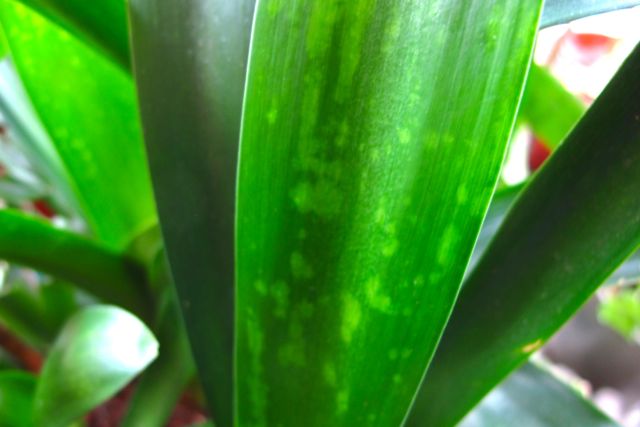| These mottled leaves on my Clivia could be telling me a sad, sad story. Oh, dear. |
You might know of my constant quest for unkillable houseplants. When I find one purported to be Helenproof, I’m on it like bees (or Battersbys) on honey. How thrilled I was to hear about Clivia, an easy-to-care-for flowering bulb or geophyte in the Amaryllis family.
It likes shade (hooray!), tolerates drought (perfect!) and, oh, was that really one (no, five bulbs in the pot) for just $5 on the members’ table at a garden club plant sale last spring? With a large Christmas cactus or two (Schlumbergera, another easy-care plant) wedged in for good measure? Sold!
But examining the emerging new leaves this week, I unhappily noticed pale blotches. Why, Google, why? Which took me to this page by Clivia enthusiast and grower Jim Shields, where I read these words, “Once a clivia plant has been infected with a virus, there is no hope of cure for it.”
Sob. Another plant ruined! I am a very unhappy girl. It spent time outdoors last summer; could that be when it was infected? In one last, desperate measure, I have emailed Mr. Shields with a picture of my leaves. Or, more properly, the leaves of my clivia. Let’s see if he replies, and what he says.
Viruses can affect a wide range of bulbs. As you can read on this page from the Pacific Bulb Society, bulbs can even catch cucumber mosaic virus – which, despite its name, has more than 1,000 possible hosts. Sometimes you’ll see the effect of a virus on tulips in your gar
den, which develop interesting streaks in their petals for a year or two, before they dwindle away to nothing. Be aware, friends.





4 comments
Oh bother. How sad. (When the picture first came up I thought they were water splashes.)
Esther, my reputation as a houseplant killer appears to be unsullied. Sigh.
Oh dear, I wish you were here in Ottawa! I have been looking for homes for some Clivias which I grew from seed. I even have a yellow one to give away…. maybe I could mail you one once the weather warms up? They really are great houseplants, easy and rewarding. No virus on mine, for sure!
Elisabeth, The update from my correspondence with Clivia expert Jim Shields is that viruses are rare and what I have on my plant(s) might be a fungal infection. I only hope he's correct*. If so, I'd love to take you up on your Clivia donation, especially the yellow one. You can email me through my business site (at the bottom of the right column).
(*The picture of clivia virus on his website, linked above, still looks to me remarkably like the leaves on my plant. See if you agree.)